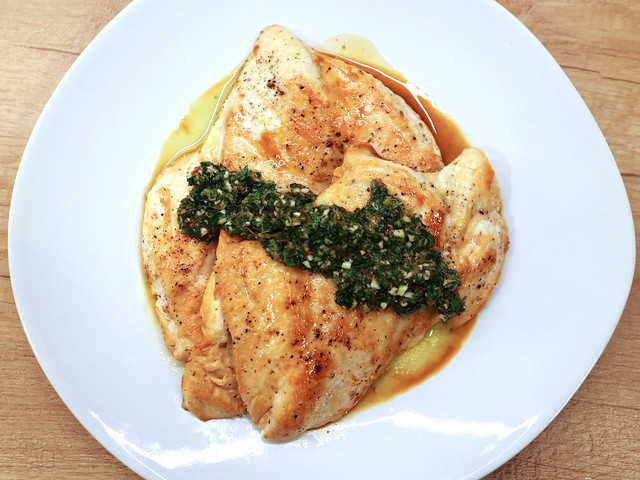Chicken Paillard (Butterflied Chicken Breast) with Italian Salsa Verde

I always say that a good test of a restaurant is how good they are at cooking chicken! And this is still true to this very day. Back in the day—by that I mean back in the early aughts—you would see chicken paillard on nearly every restaurant menu. This was a good test for a restaurant: a butterflied chicken breast. You can easily get this really right or really wrong, that is perfectly moist vs bone dry. But this is one of those dishes that's so easy to make at home, that there's no reason to order it—unless your testing the restaurant like I'd do!
Butterflying a chicken breast isn't hard at all. It's just a matter of following the anatomy, the contours of the chicken breast. Although many cooks like to pound chicken breast to get it to an even thickness, I prefer butterflying it. There's less of a chance of going too far and completely tearing up the fibers of the meat. Not to mention, the thinner you pound a piece of meat, the higher the chance of it drying out during searing. So my advice is stick to butterflying the chicken and pressing on it firmly to get an even 1/2-inch thickness.
To serve on top of (or alongside) the chicken breasts, I like to make a salsa verde. This is the Italian salsa verde made with parsley, capers, lemon, and garlic, and a bit of red pepper flakes for a subtle kick. This is one of my favorite condiments to serve on meat or fish. It's great on roast chicken, too! The salsa verde recipe below makes a larger batch so you can keep it in your refrigerator for future meals.
Chicken Paillard
Note: For deglazing the pan, I recommend using a flavorful liquor like Akvavit or Pernod, or a fortified wine like vermouth. But you could also use a sweet or semi-sweet white wine.2 boneless, skinless, chicken breasts
fine sea salt
freshly ground black pepper
olive oil
1/4 cup Akvavit, Pernod, or Vermouth
Begin by butterflying each chicken breast. Starting from the backside of the breast, score lengthwise along the separation between the larger and smaller muscles. Slice, little by little, into the smaller muscle first and then the larger muscle until you can open them up. Flip the chicken breast over and press on it using a paper towel or plastic wrap for leverage. Each breast should be about a 1/2-inch thickness.
Preheat a large skillet at medium to medium-high heat.
Liberally season both sides of each breast with salt and pepper.
Add oil to the skillet and swirl to coat the bottom. Add the chicken breasts. Sear until the sizzling has subsided, and the meat no longer sticks, about 3 to 5 minutes. Flip the breasts, and sear for 3 minutes.
To deglaze the pan, add a few splashes of Akvavit to the skillet. This will help release any of the brown bits from the skillet. Remove the chicken to a plate, and add the remaining Akvavit to the hot skillet and scrape up the remaining brown bits. Pour this pan sauce over the chicken breasts. Top the chicken breasts with salsa verde and serve immediately. Yield: 2 servings.
Salsa Verde
1 lemon, zested and juiced2 tablespoons capers, finely chopped
3 to 4 garlic cloves, finely chopped
1/2 cup finely chopped parsley
1 to 2 teaspoons red pepper flakes
fine sea salt
freshly ground black pepper
1/4 cup olive oil
Combine the lemon zest and juice, chopped capers, chopped garlic, chopped parsley, and red pepper flakes in a bowl. Season with salt and pepper. Stir in the olive oil. Serve immediately or store in an airtight jar or container for up to 1 week in the refrigerator. Yield: 1 cup.
Comments
Post a Comment